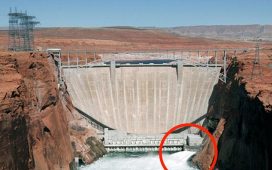Russia to send a spacecraft to the MOON for the first time in 45 years in a bid to find water on its surface
- Russian agency Roscosmos will send Luna-25 to the Moon on October 1, 2021
- It will mark the first time Moscow has landed on the Moon since Luna-24 in 1976
- The mission will see Luna-25 examine the surface soil in a search for water ice
- A follow up mission in partnership with ESA will aim to extract water by 2025
Russia is sending its first spacecraft to the Moon in 45 years and will explore the polar regions in a bid to try and find water on the lunar surface.
The Lunar-25 lander will be the first Russian spacecraft to land on the surface of the Moon since 1976 – when Lunar-24 touched down.
It’s expected to launch for the Moon on October 1, 2021 and will carry out scientific research in the polar regions – including a hunt for water.
It will be one of up to five launches to explore the surface and sub-surface of the Moon over the next decade, Roscosmos confirmed.
Scroll down for video

Luna-25 will launch in October 2021 and land at the lunar pole to search for signs of ice water that could help in future missions to and from the Moon

The Luna-25 rover will head to the Moon’s polar regions in search of ice water. It will take scientific equipment to sample the soil
Russia isn’t the only country heading to the Moon, countries including China, India and the USA are also working on lunar programmes.
The USA’s Artemis mission is expected to see the first woman stand on the lunar surface by the middle of the decade.
‘The return to the moon will be a strong claim on leadership in space,’ Ivan Moiseyev, head of the Space Policy Institute in Moscow, told The Telegraph.
The original Luna programme was a series of robotic spacecraft missions to the Moon between 1959 and 1976.
Luna 9 in February 1966 became the first probe to make a soft landing on another planetary body and send five black and white pictures back of the lunar surface.
This was at the height of the space race between the USA and the Soviet Union that eventually ended when Neil Armstrong became the first man to walk on the Moon.
Since the end of the space race other nations have entered the fray including China, whose Chang’e 4 probe was the first to land on the dark side of the Moon last year.
India is also working on another attempt to successfully land a rover on the surface of the Moon after earlier failed attempts.
The White House has spoke about the need to bring US astronauts back to the Moon by 2024 – something NASA says it a stepping stone to an eventual landing on Mars.
The Luna 25 probe will conduct a series of scientific experiments on soil samples from the surface in the hope of finding ‘water on the Moon’.
‘The first country to discover water will cause a sensation,’ Moiseyev said.
Finding water on the Moon will make not just future lunar missions more viable, but also missions to Mars and possible asteroid explorations.

Apollo 8, the first manned mission to the moon, entered lunar orbit on Christmas Eve, Dec. 24, 1968 and the astronauts captured this image of the Earth rising in the lunar sky. Future missions will become more viable if water is found on the Moon, say Roscosmos
This is a joint mission with the European Space Agency (ESA) who are contributing a robot drill to help in the search for water.
Luna-25 will include a Pilot-D camera and hazard detection software created by ESA to image the terrain and help it land on the surface.
This will then help prepare for the more complex mission a few years later when Luna-27 begins ‘prospecting on the Moon’.
Russia and ESA hope to be able to extract water from the Moon by 2025.
The main goal of the Luna-27 lander is to study the composition of the soil near the lunar south pole.
Water is a key target as there may be concentrations of frozen water at or below the surface, according to an ESA report.















